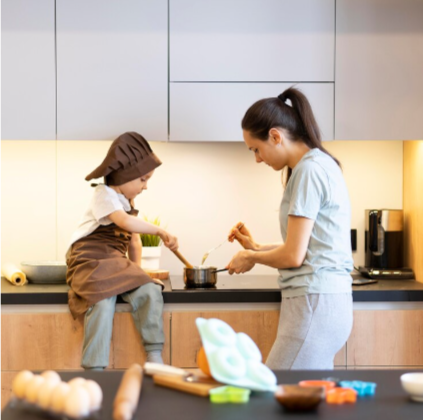Introduction
Though a hive of family activity, the kitchen may also be a child’s worst nightmare in terms of hazards. As a result of the numerous child-related mishaps in non childproofing kitchens each year, childproofing kitchen efforts are concentrated there. This post will walk you through reducing the risks in your childproofing kitchens and providing useful fixes so your kids may play in a safer setting.
Recognizing the Hazards
There are several risks in non-childproofing kitchens, including hot surfaces, sharp objects, and poisonous materials. These risks are particularly high for toddlers, who are naturally curious and like to investigate their surroundings. Although older kids may be more aware of overt threats, their growing motor and cognitive abilities can still endanger them.
Safeguarding Equipment and Appliances
Modern childproofing kitchens are equipped with a range of appliances that, although making cooking and storage easier, can be dangerous for youngsters. The following advice can help you secure them:
Use oven and stove shields and knob covers to keep unintentional turns on. When not in use, make sure the oven door is locked.
Small Appliances: Keep gadgets like toasters and blenders locked in cabinets or out of reach.
Sharp Tools: Use childproof locks on drawers of childproofing kitchens to keep knives, forks, and other sharp objects.
Childproofing Drawers and Cabinets

Drawers and cabinets may include sharp objects or dangerous materials. You can help keep items out of the reach of youngsters by installing childproof locks or latches. Ensure that harmful products such as plastic bags and cleaning agents are kept in upper cabinets.
Electrical Security
Sockets: Use safety plugs to cover unused electrical sockets.
Cords: Keep cords away from edges so kids can’t tug on them.
How to Avoid Burns and Scalds
When cooking, turn pot handles toward the back of the stove and use the back burners.
Hot Liquids: Keep hot food and beverages away from table and counter edges.
Proper Food Storage and Sanitation
Foods that can cause choking hazards should be kept out of reach, such as hard candies and nuts.
Cleanliness: Prevent foodborne infections by keeping your environment clean.
Making the childproofing kitchens kid-friendly
Play Area: Consider building a safe play area in the kitchen where children may engage while you prepare.
Things: Give older kids age-appropriate culinary things to do.
Being Ready for Emergencies
First Aid: Learn the fundamentals of first aid procedures and have a first aid kit in the kitchen.
Emergency Contacts: Keep a list of contacts for emergencies, especially poison control, close to hand.
Teaching Your Youngster
Instruct your kids on kitchen safety. Describe the risks associated with specific appliances and the significance of avoiding them.
Frequent Inspection and Upkeep
Your child’s skills and the risks they encounter will evolve as they get older. Review your kitchen frequently for possible risks, and adjust your safety precautions as necessary.
Advanced Methods for Childproofing kitchens
Safeguarding the Freezer and Refrigerator
Install appliance locks to keep kids from getting to potentially hazardous items kept in the freezer or refrigerator.
Safe Storage: Put potentially dangerous things on higher shelves, such as glass containers, alcoholic beverages, and choking risks.
Managing Waste and Recycling in a Safe Way
Use child-resistant lids on secure bins to keep hazardous materials out of reach.
Location: Store the bins in a lockable cabinet or a child-proofed place.
Using Technology to Improve Safety
Intelligent Safety Equipment
Smart Locks: Take into consideration adding remotely operated smart locks to cupboards and appliances.
Install motion sensors to receive alerts when a child wanders into the kitchen unattended.
Creating a Kitchen That Is Safe and Ergonomic for Children
Lower Countertops: For safe access, lower countertops should be considered in families with older children who engage in culinary activities.
Non-Slip Flooring: Select materials for your flooring that will lessen the chance of trips and falls.
Awareness of Nutrition and Health
Safe Cooking Techniques
Teaching Nutrition: To teach kids about nutrition and safe cooking techniques, get them involved in the process of making nutritious meals.
Supervised Cooking: Give older kids opportunities to practice basic cooking techniques under supervision.
Cultural and Behavioural Aspects
Considering Curiosity
Provide kids with opportunity to safely explore the kitchen, such as by letting them play with non-hazardous kitchenware.
Cultural customs: Take into account the particular customs from your family’s culture in the kitchen and how they might be modified to ensure safety.
The Function of Adult Guidance
Continuous Watchfulness
Active Supervision: Recognize that childproofing is an addition to active adult supervision—it is not a substitute for it.
Setting Boundaries: Teach children clear boundaries about what is and isn’t acceptable in the kitchen.
Frequent Modifications and Adjustments
Staying Ahead of Changes
Growth and Development: Adapt childproofing techniques on a regular basis to your child’s evolving needs.
Novel Items and Advancements: Keep up with the latest advancements in technology and childproofing items to improve safety.
Improved Safety Protocols
Kitchen Fire Safety
Make sure that the smoke alarms next to the kitchen are in working order.
Fire Extinguisher: Keep one in the kitchen and become familiar with how to use it.
How to Avoid Slips and Falls
Non-Slip Mats: Put non-slip mats in high-spill areas.
Organize Space: Remove any toys, tiny gadgets, and other anything that could trip people off the kitchen floor.
Including Kids in Safety
Engaging Education
Safety Games: Make games that instruct kids on kitchen safety, such as spotting potentially harmful objects.
Reward Systems: Establish a system of rewards for adhering to safety regulations.
Creating Recipes That Are Kid-Friendly
Simple meals: Provide a range of risk-free, kid-friendly meals that are easy to prepare.
Cooking Classes With Supervision: Arrange cooking classes so kids can pick up the fundamentals of cooking under adult supervision.
Secure Kitchen Design and Layout
Arrangement of the Kitchen for Safety
Strategic Placement: Set up your kitchen so that potentially dangerous spots are out of reach for young children.
Visibility: Make sure your cooking or work area has easy access to your child’s play area.
Tools & Utensils That Are Safe for Kids
Safe Utensils: Make an investment in kid-friendly kitchenware such non-breakable dishes and plastic knives.
Accessible Storage: To promote older children’s safe involvement in culinary activities, keep these kid-friendly tools in an accessible location.
Advanced Child Monitoring with Cameras and Baby Monitors
When you’re not in the kitchen, use audio monitors to keep an ear out for any strange noises.

Installing video monitors will allow you to watch over kids when you’re in another room.
The Value of Continual Safety Inspections
Frequent Inspections for Safety
Scheduled Checks: Make sure all safety precautions are in place and operating properly by auditing your kitchen on a regular basis.
Including Experts: Have a professional childproofer look over your kitchen to make sure there are no hidden dangers.
Creating a Safety Culture
Family Safety Procedures
Family Meetings: Have frequent family get-togethers to talk about kitchen safety and get input.
Setting a good example by adhering to safety procedures yourself is known as role modeling.
Resources and Assistance from the Community
Attend neighborhood workshops on child safety to stay current on recommended procedures.
Internet Resources: For more advice and assistance, check out forums and other online resources.
Conclusion
The process of childproofing your kitchen involves several steps, including installing safety equipment, conducting education campaigns, and setting up a space where people are aware of safety. You can guarantee that your kitchen will always be a fun and safe place for your whole family to be by paying attention to your child’s developing needs and keeping up with the most recent safety precautions. Recall that while safety precautions and regulations are important, they work best when accompanied by close supervision and a home safety culture.
Protecting your child’s safety by childproofing your kitchen is a dynamic and important process. By putting these precautions in place and keeping them updated on a regular basis, you can give your kids a safe space to develop, learn, and explore. Recall that the objective is to strike a balance between family moments spent in the kitchen, the center of your house, and safety.
The process of childproofing your kitchen is continuous and changes as your child does. You can make your home a safer place for your family by being aware of the possible hazards and taking preventative action. Recall that although safety measures are necessary, close monitoring is priceless. Enjoy the peace of mind that comes with having a well-childproofed kitchen while keeping an eye on your kids.
We hope you found this information helpful in your journey to create a safer environment for your family. At GuardWell Safety, we understand that every home is unique, and so are your child-proofing needs. That’s why we offer a Free Child-Proofing Consultation tailored to your specific requirements. Let our experts help you identify potential hazards and provide personalized solutions to make your home a secure haven for your little ones. Book your free consultation today and take the first step towards peace of mind.






